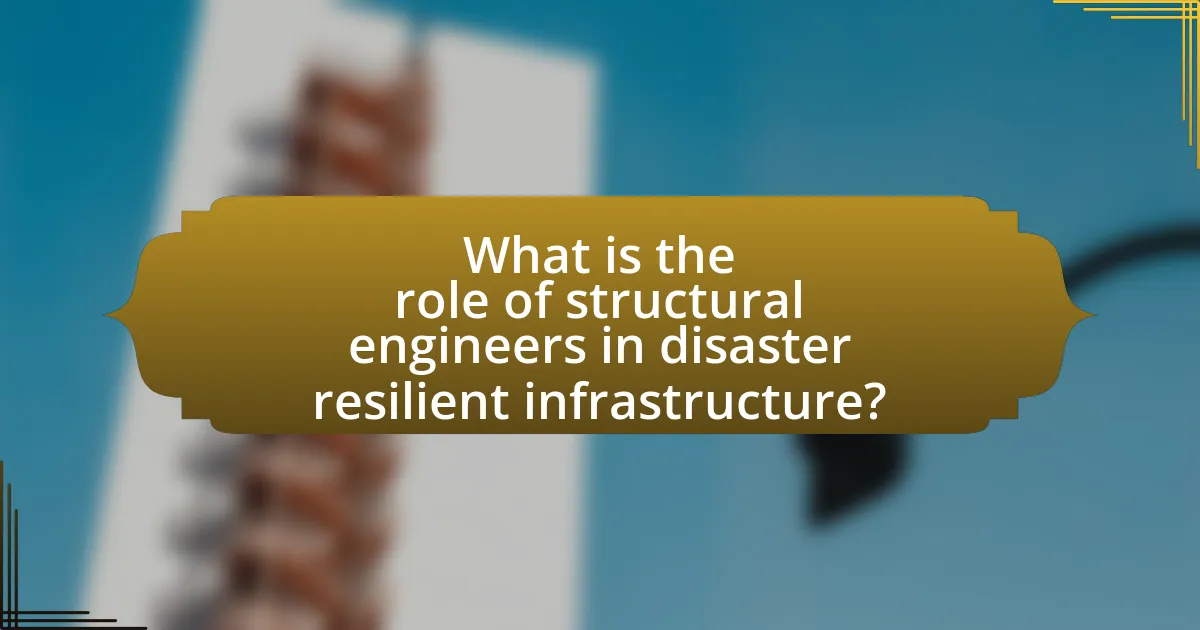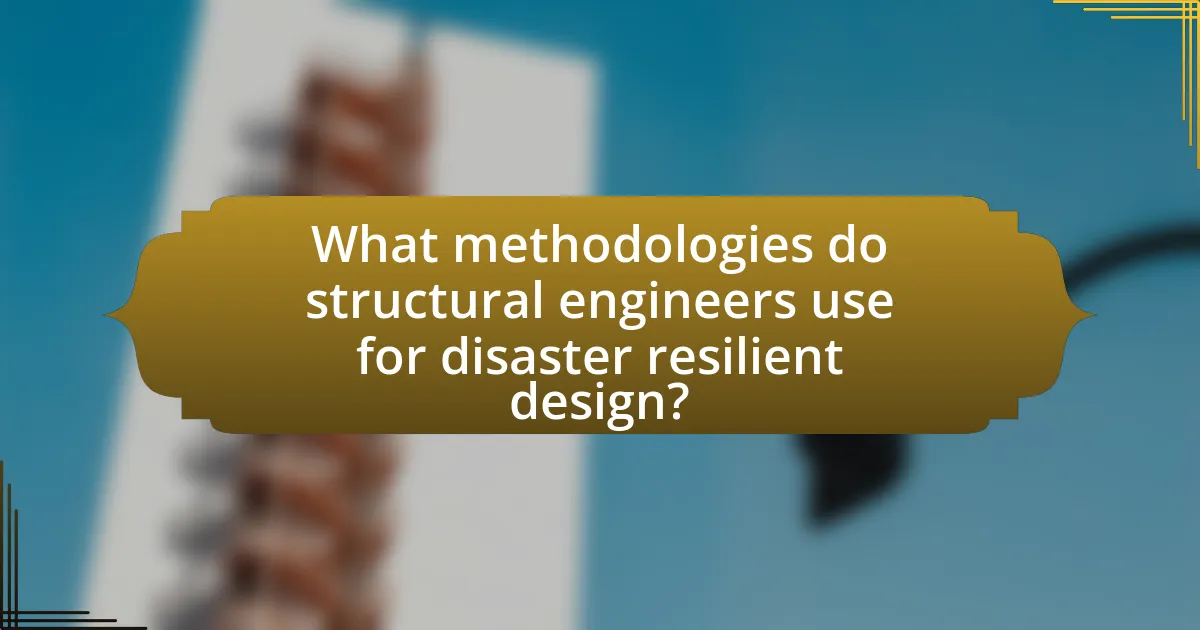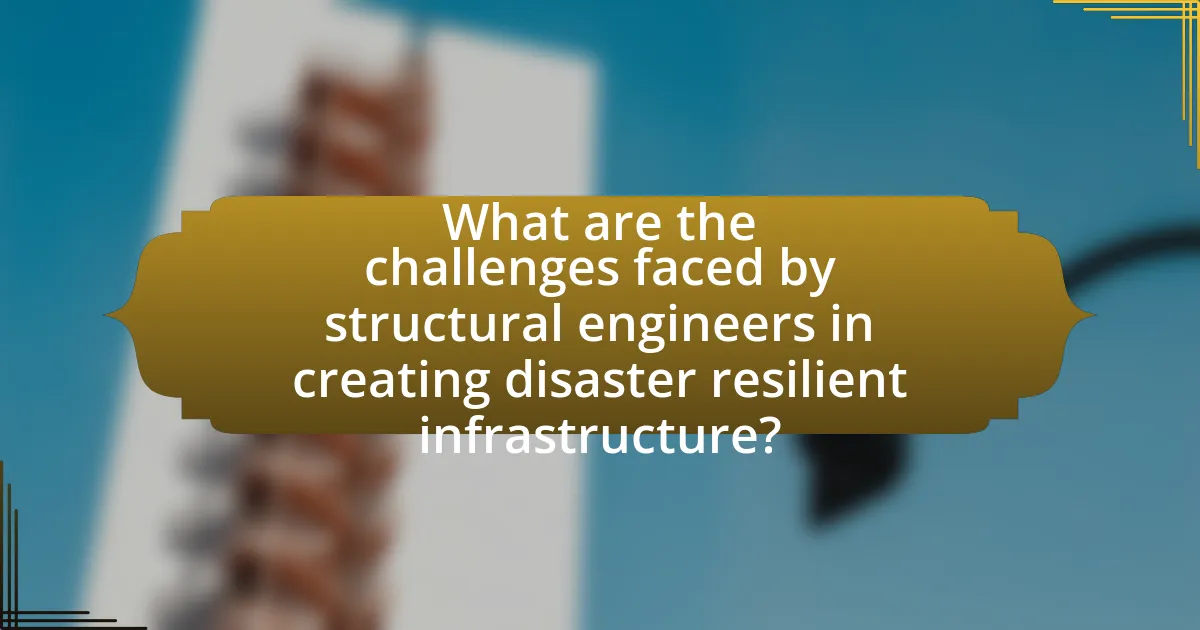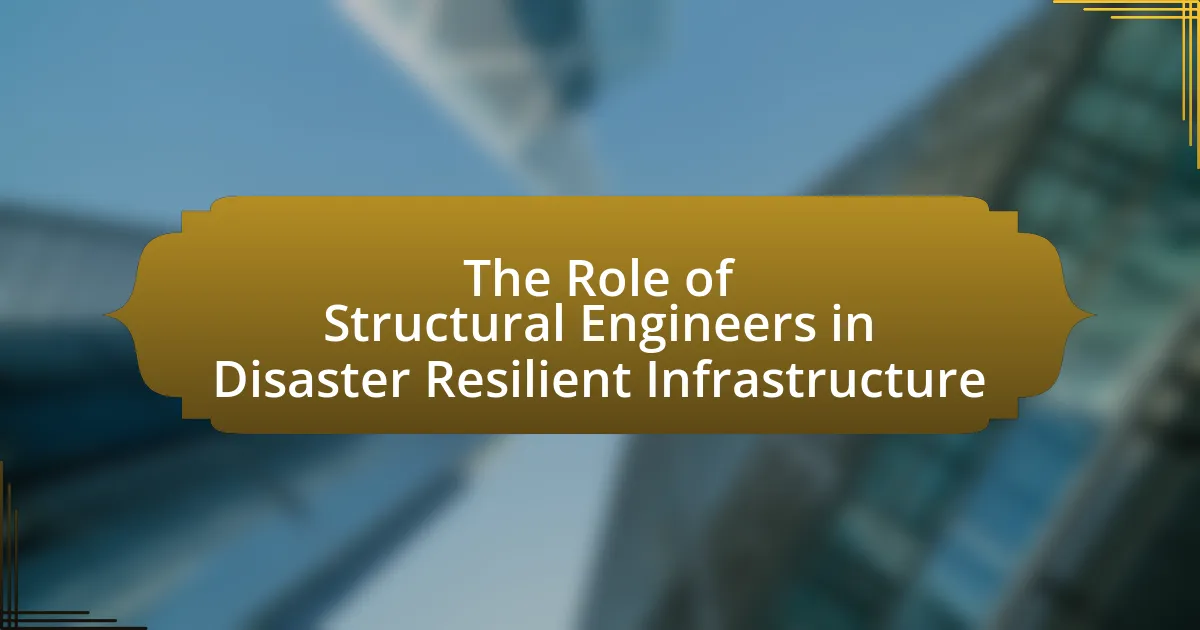Structural engineers are essential in the development of disaster-resilient infrastructure, focusing on designing buildings and systems that can withstand natural hazards such as earthquakes, floods, and hurricanes. They employ advanced materials and engineering principles to enhance structural integrity and minimize damage during disasters, significantly reducing recovery costs and protecting lives. The article explores the specific skills and methodologies structural engineers utilize, including risk assessment and performance-based design, while also addressing the challenges they face, such as budget constraints and regulatory hurdles. Additionally, it highlights the importance of community involvement and collaboration among various professionals to improve disaster resilience in infrastructure projects.

What is the role of structural engineers in disaster resilient infrastructure?
Structural engineers play a critical role in designing and implementing disaster-resilient infrastructure by ensuring that structures can withstand natural hazards such as earthquakes, floods, and hurricanes. They utilize advanced engineering principles and materials to create buildings and infrastructure that not only meet safety standards but also minimize damage during disasters. For instance, the incorporation of flexible materials and innovative design techniques can significantly enhance a structure’s ability to absorb and dissipate energy from seismic events. Research indicates that buildings designed with these considerations can reduce damage costs by up to 50% during earthquakes, demonstrating the effectiveness of structural engineering in enhancing resilience.
How do structural engineers contribute to disaster resilience?
Structural engineers contribute to disaster resilience by designing buildings and infrastructure that can withstand extreme events such as earthquakes, floods, and hurricanes. Their expertise in materials, load distribution, and structural integrity enables them to create systems that minimize damage and protect lives during disasters. For instance, the incorporation of seismic design principles in earthquake-prone areas has been shown to reduce structural failure rates significantly, as evidenced by the performance of buildings during the 2011 Tōhoku earthquake in Japan, where modern engineering practices led to fewer casualties and less damage compared to older structures.
What specific skills do structural engineers bring to disaster resilient projects?
Structural engineers bring critical skills to disaster resilient projects, including advanced knowledge of materials, structural analysis, and risk assessment. Their expertise in selecting appropriate materials ensures that structures can withstand extreme conditions, such as earthquakes or floods. Structural analysis skills enable engineers to evaluate how different forces affect a building’s integrity, allowing for the design of safer structures. Additionally, risk assessment capabilities help identify potential vulnerabilities in designs, leading to proactive measures that enhance resilience. These skills are essential for creating infrastructure that can endure and recover from disasters effectively.
How do structural engineers assess risks in infrastructure design?
Structural engineers assess risks in infrastructure design by conducting thorough analyses that include evaluating environmental conditions, material properties, and structural loads. They utilize methodologies such as risk assessment frameworks, which involve identifying potential hazards, analyzing their likelihood, and determining the consequences of structural failure. For instance, engineers often apply probabilistic seismic hazard assessments to quantify the risk of earthquakes in a given area, allowing them to design structures that can withstand specific seismic forces. Additionally, they may use computer simulations to model structural responses under various scenarios, ensuring that designs meet safety standards and regulatory requirements. This systematic approach is supported by guidelines from organizations like the American Society of Civil Engineers, which emphasizes the importance of risk management in infrastructure projects.
Why is disaster resilience important in infrastructure design?
Disaster resilience is crucial in infrastructure design because it ensures the safety, functionality, and sustainability of structures during and after catastrophic events. Infrastructure that incorporates disaster resilience can withstand natural disasters such as earthquakes, floods, and hurricanes, minimizing damage and protecting lives. For instance, the Federal Emergency Management Agency (FEMA) reports that resilient infrastructure can reduce recovery costs by up to 50% and significantly decrease the time needed for communities to return to normalcy. This highlights the importance of integrating disaster resilience into the design process to safeguard investments and enhance community resilience.
What are the potential impacts of disasters on infrastructure?
Disasters can severely damage infrastructure, leading to significant economic and social consequences. For instance, natural disasters like earthquakes can cause structural failures in buildings and bridges, resulting in loss of life and property. According to the National Institute of Building Sciences, every dollar spent on disaster mitigation can save society an average of six dollars in future disaster costs. Additionally, infrastructure disruptions can hinder emergency response efforts, delay recovery, and impact essential services such as water supply, electricity, and transportation. The 2011 earthquake and tsunami in Japan exemplified this, as it caused extensive damage to roads, railways, and power plants, leading to prolonged recovery efforts and economic losses estimated at over $360 billion.
How does disaster resilient infrastructure benefit communities?
Disaster resilient infrastructure benefits communities by reducing vulnerability to natural hazards and minimizing damage during disasters. This type of infrastructure is designed to withstand extreme weather events, earthquakes, and floods, thereby protecting lives and property. For example, buildings constructed with resilient materials and techniques can endure seismic activity, as evidenced by the 2011 earthquake in Japan, where resilient structures significantly reduced casualties and economic losses. Additionally, resilient infrastructure promotes quicker recovery and continuity of essential services, which is crucial for community stability and resilience.

What methodologies do structural engineers use for disaster resilient design?
Structural engineers use methodologies such as performance-based design, risk assessment, and resilient design principles for disaster resilient design. Performance-based design focuses on ensuring structures can withstand specific hazards by evaluating their expected performance under various conditions. Risk assessment involves identifying potential hazards, analyzing vulnerabilities, and determining the likelihood of different disaster scenarios to inform design decisions. Resilient design principles emphasize adaptability and sustainability, ensuring structures can recover quickly from disasters while minimizing damage. These methodologies are supported by standards such as ASCE 7, which provides guidelines for designing buildings to resist natural hazards, demonstrating their effectiveness in enhancing disaster resilience.
How do engineers incorporate risk assessment in their designs?
Engineers incorporate risk assessment in their designs by systematically identifying, analyzing, and mitigating potential hazards that could impact the safety and functionality of structures. This process involves utilizing tools such as failure mode and effects analysis (FMEA) and probabilistic risk assessment (PRA) to evaluate the likelihood and consequences of various risks, including natural disasters like earthquakes and floods. For instance, the American Society of Civil Engineers (ASCE) emphasizes the importance of integrating risk assessment into the design phase to enhance resilience, ensuring that structures can withstand extreme events. By applying these methodologies, engineers can prioritize design features that enhance safety and durability, ultimately leading to more resilient infrastructure capable of withstanding unforeseen challenges.
What tools and technologies assist structural engineers in risk assessment?
Structural engineers utilize various tools and technologies for risk assessment, including Building Information Modeling (BIM), finite element analysis software, and Geographic Information Systems (GIS). BIM allows for detailed visualization and simulation of structures, enabling engineers to identify potential risks during the design phase. Finite element analysis software, such as ANSYS or SAP2000, helps in assessing structural integrity under various load conditions, providing insights into failure points. GIS technology aids in analyzing geographical data to evaluate environmental risks, such as flood zones or seismic activity, thereby informing design decisions. These tools collectively enhance the accuracy and efficiency of risk assessments in structural engineering.
How do engineers prioritize risks in their design processes?
Engineers prioritize risks in their design processes by conducting thorough risk assessments that evaluate the likelihood and impact of potential failures. This systematic approach involves identifying hazards, analyzing their consequences, and determining the probability of occurrence, often using quantitative methods such as fault tree analysis or failure mode and effects analysis. For instance, in structural engineering, risks related to natural disasters like earthquakes or floods are prioritized based on historical data and modeling techniques that predict structural performance under various conditions. This prioritization ensures that critical risks are addressed first, leading to safer and more resilient infrastructure.
What design principles are essential for disaster resilience?
Essential design principles for disaster resilience include redundancy, robustness, and flexibility. Redundancy ensures that critical systems have backup components, which can maintain functionality during disasters. Robustness refers to the ability of structures to withstand extreme forces, such as earthquakes or floods, without significant damage. Flexibility allows structures to adapt to changing conditions and stresses, reducing the likelihood of failure. These principles are supported by engineering standards and practices, such as those outlined in the ASCE 7 standard for minimum design loads for buildings and other structures, which emphasizes the importance of these attributes in creating resilient infrastructure.
How do engineers ensure structural integrity during disasters?
Engineers ensure structural integrity during disasters by implementing rigorous design standards, utilizing advanced materials, and conducting thorough risk assessments. These practices involve adhering to building codes that account for potential hazards such as earthquakes, floods, and wind loads. For instance, the International Building Code provides guidelines that help engineers design structures capable of withstanding extreme conditions. Additionally, engineers often use materials like reinforced concrete and steel, which have proven resilience in disaster scenarios. Research indicates that structures designed with these considerations can significantly reduce damage and enhance safety during catastrophic events, as evidenced by the performance of buildings during the 2011 Tōhoku earthquake in Japan, where adherence to seismic codes minimized structural failures.
What role does material selection play in disaster resilient infrastructure?
Material selection is crucial in disaster resilient infrastructure as it directly influences the structure’s ability to withstand extreme events such as earthquakes, floods, and hurricanes. The choice of materials affects not only the strength and durability of the infrastructure but also its flexibility and energy absorption capabilities during disasters. For instance, using high-performance concrete and steel can enhance structural integrity, while materials like fiber-reinforced polymers can provide additional resilience against seismic forces. Research indicates that structures designed with appropriate materials can reduce damage by up to 50% during seismic events, demonstrating the significant impact of material selection on overall safety and longevity.

What are the challenges faced by structural engineers in creating disaster resilient infrastructure?
Structural engineers face several challenges in creating disaster-resilient infrastructure, including the need for advanced materials, adherence to evolving building codes, and the integration of innovative design techniques. Advanced materials, such as high-performance concrete and steel, are essential for enhancing structural integrity but can be costly and require specialized knowledge for implementation. Additionally, building codes are continually updated to reflect new research and lessons learned from past disasters, necessitating ongoing education and adaptation by engineers to ensure compliance. Furthermore, integrating innovative design techniques, such as seismic retrofitting and flood-resistant features, demands a balance between functionality, aesthetics, and cost-effectiveness, complicating the engineering process. These challenges are compounded by the increasing frequency and intensity of natural disasters due to climate change, which requires engineers to anticipate and mitigate risks more effectively.
What are common obstacles in implementing disaster resilience strategies?
Common obstacles in implementing disaster resilience strategies include insufficient funding, lack of stakeholder engagement, and inadequate data for risk assessment. Insufficient funding limits the ability to invest in necessary infrastructure improvements and community preparedness programs. Lack of stakeholder engagement often results in strategies that do not reflect the needs or priorities of the affected communities, leading to ineffective implementation. Inadequate data for risk assessment hinders the ability to identify vulnerabilities and prioritize interventions, making it difficult to develop targeted resilience strategies. These challenges are documented in various studies, including the National Institute of Building Sciences’ “Natural Hazard Mitigation Saves” report, which highlights the importance of funding and community involvement in effective disaster resilience planning.
How do budget constraints affect disaster resilient design?
Budget constraints significantly limit the effectiveness of disaster resilient design by restricting the materials, technologies, and methodologies that can be employed. When financial resources are inadequate, structural engineers may opt for less durable materials or simplified designs that do not fully address potential hazards, ultimately compromising safety and resilience. For instance, a study by the National Institute of Building Sciences indicates that investing in resilient infrastructure can save communities up to $4 for every $1 spent on mitigation efforts, highlighting the long-term cost-effectiveness of prioritizing resilience despite initial budget limitations.
What regulatory challenges do engineers encounter in disaster resilience projects?
Engineers encounter several regulatory challenges in disaster resilience projects, including compliance with evolving building codes, obtaining necessary permits, and navigating complex zoning laws. These challenges arise because building codes often change in response to new scientific data or past disaster events, requiring engineers to stay updated and adapt their designs accordingly. Additionally, the permitting process can be lengthy and bureaucratic, delaying project timelines and increasing costs. Zoning laws may restrict the types of structures that can be built in certain areas, complicating the implementation of innovative resilience strategies. These regulatory hurdles can hinder the effectiveness and efficiency of disaster resilience initiatives, ultimately impacting community safety and recovery efforts.
How can collaboration enhance disaster resilience in infrastructure?
Collaboration enhances disaster resilience in infrastructure by facilitating the sharing of knowledge, resources, and best practices among various stakeholders, including engineers, government agencies, and community organizations. This collective approach allows for the integration of diverse expertise, leading to more robust design and construction practices that can withstand disasters. For instance, the National Institute of Standards and Technology (NIST) emphasizes that collaborative efforts in post-disaster assessments can identify vulnerabilities and inform future infrastructure improvements, ultimately reducing risks and enhancing community preparedness.
What roles do other professionals play alongside structural engineers?
Other professionals, such as architects, civil engineers, geotechnical engineers, and construction managers, collaborate with structural engineers to ensure the successful design and implementation of disaster-resilient infrastructure. Architects focus on the aesthetic and functional aspects of buildings, ensuring that the design meets both safety and usability standards. Civil engineers contribute to the overall infrastructure planning, integrating transportation and utility systems with structural designs. Geotechnical engineers assess soil conditions and provide insights on foundation stability, which is crucial for structures in disaster-prone areas. Construction managers oversee the construction process, ensuring that structural engineers’ designs are executed correctly and safely. This multidisciplinary collaboration enhances the resilience of infrastructure against disasters, as evidenced by the integration of diverse expertise in projects like the reconstruction of New Orleans post-Hurricane Katrina, where coordinated efforts led to improved building codes and disaster preparedness strategies.
How can community involvement improve disaster resilience efforts?
Community involvement can significantly improve disaster resilience efforts by fostering local knowledge, enhancing preparedness, and promoting collaborative response strategies. Engaging community members allows for the identification of specific vulnerabilities and resources unique to the area, which can inform tailored disaster response plans. Research indicates that communities with active participation in disaster planning and response exhibit a 30% increase in resilience outcomes, as they are better equipped to mobilize resources and support during emergencies. Furthermore, community-led initiatives often lead to stronger social networks, which are crucial for effective communication and resource sharing in times of crisis.
What best practices should structural engineers follow for disaster resilient infrastructure?
Structural engineers should prioritize the use of robust design principles, materials, and construction techniques to ensure disaster-resilient infrastructure. This includes adhering to building codes that account for local hazards, such as earthquakes, floods, and hurricanes, which are essential for minimizing structural failure during disasters. For instance, the International Building Code provides guidelines that enhance safety and resilience in various environmental conditions.
Additionally, engineers should implement redundancy in structural systems, allowing buildings to maintain integrity even if one component fails. Research indicates that structures designed with redundancy can significantly reduce the risk of catastrophic failure during extreme events. Furthermore, incorporating flexible materials and designs can help absorb and dissipate energy from seismic activities, as evidenced by the performance of base-isolated buildings during earthquakes.
Regular maintenance and retrofitting of existing structures are also critical best practices. Studies show that updating older buildings to meet current safety standards can greatly improve their resilience against disasters. Lastly, engaging in community planning and risk assessment ensures that infrastructure is strategically located and designed to withstand potential hazards, thereby enhancing overall safety and resilience.
How can ongoing education and training improve disaster resilience skills?
Ongoing education and training enhance disaster resilience skills by equipping individuals with the latest knowledge and techniques necessary for effective disaster response and recovery. Continuous learning ensures that structural engineers and other professionals stay updated on advancements in materials, technologies, and methodologies that improve infrastructure resilience. For instance, research by the National Institute of Standards and Technology indicates that training in modern design practices can significantly reduce structural failures during disasters. Furthermore, regular drills and simulations foster practical skills and teamwork, which are critical during actual disaster scenarios. This combination of theoretical knowledge and practical experience ultimately leads to more robust disaster preparedness and response capabilities.
What are the key takeaways for engineers working on disaster resilient projects?
Engineers working on disaster resilient projects should prioritize risk assessment, design flexibility, and community engagement. Risk assessment involves identifying potential hazards and vulnerabilities to inform design choices, ensuring structures can withstand extreme events. Design flexibility allows for adaptability in response to changing environmental conditions and emerging technologies, enhancing resilience. Community engagement fosters collaboration with local stakeholders, ensuring that projects meet the specific needs and concerns of the population, which is crucial for effective disaster response and recovery. These takeaways are supported by the increasing frequency of natural disasters, which necessitate innovative engineering solutions to protect lives and property.

Leave a Reply